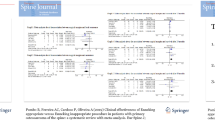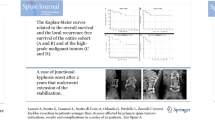Abstract
Purpose
To define the role of Enneking staging system and of the consequent different treatment options on the outcome of osteoblastoma (OBL) of the spine.
Methods
A retrospective review of 51 patients with OBL of the mobile spine conducted to compare the outcomes among the different types of treatments at long term follow-up (25–229 months, av.90). These 51 patients were previously staged according to Enneking staging system and treatment selected accordingly. 10 stage two (st.2) OBLs were treated with intralesional excision and 41 stage three (st.3) OBLs were treated either by intralesional excision or en bloc resection. The intralesional excision group was divided considering the use or not of radiation therapy after surgery. The recurrence rate was compared among these groups and also considering previous open surgery (“non intact” vs. “intact”). The statistical significance was defined using the Fisher Exact test.
Results
No local recurrence occurred in the st.2 patients treated by intralesional excision. Considering the st.3 patients, 2 local recurrences out of 13 patients occurred in the en bloc resection (15.4 %) group. All occurred in “non intact” cases (67 %). In the intralesional group, 5 local recurrences out of 27 patients occurred (18 %) being none in the group that received radiation therapy after surgery. Two occurred in the “intact” (7 %) and three in the “non intact” group (75 %). Considering all patients, the difference between the recurrence rate between “intact” and “non intact” groups was statistically significant (p < 0.002).
Conclusions
Intralesional excision proved to be effective in st.2 lesions and en bloc resection in st.3. Radiotherapy seems to be an effective adjuvant treatment when en bloc resection is not feasible or requires unacceptable functional sacrifices. The first treatment significantly affects the prognosis as previously treated patients have worse prognosis.




Similar content being viewed by others
References
Jaffe HL (1956) Benign osteoblastoma. Bull Hosp Joint Dis 17(2):141–151
Lichtenstein L (1956) Benign osteoblastoma: a category of osteoid-and bone-forming tumors other than classical osteoid osteoma, which may be mistaken for giant-cell tumor or osteogenic sarcoma. Cancer 9(5):1044–1052
Janin Y, Epstein JA, Carras R, Khan A (1981) Osteoid osteomas and osteoblastomas of the spine. Neurosurgery 8(1):31–38
Unni KK (1996) Benign Osteoblastoma. Dahlin’s Bone Tumors. General Aspects and Data on 11,087 Cases, 5th edn. Lippincott-Raven, Philadelphia, pp 131–142
Burn SC, Ansorge O, Zeller R, Drake JM (2009) Management of osteoblastoma and osteoid osteoma of the spine in childhood. J Neurosurg Pediatr 4(5):434–438
Saccomanni B (2009) Osteoid osteoma and osteoblastoma of the spine: a review of the literature. Curr Rev Musculoskelet Med 2(1):65–67
Zileli M, Cagli S, Basdemir G, Ersahin Y (2003) Osteoid osteomas and osteoblastomas of the spine. Neurosurg Focus 15(5):E5
Dahlin DC, Johnson EW (1954) Giant osteoid osteoma. J Bone Joint Surg 36-A(3):559–572
Jaffe HL (1935) Osteoid osteoma: a benign osteoblastic tumor composed of osteoid and atypical bone. Arch Orthop Trauma Surg 31:709–728
Marsh BW, Bonfiglio M, Brady LP, Enneking WF (1975) Benign osteoblastoma: range of manifestations. J Bone Joint Surg Am 57(1):1–9
Boriani S, Capanna R, Donati D, Levine A, Picci P, Savini R (1992) Osteoblastoma of the spine. Clin Orthop Relat Res 278:37–45
Enneking WF (1986) A system of staging musculoskeletal neoplasms. Clin Orthop Relat Res 204:9–24
Chan P, Boriani S, Fourney DR et al (2009) An assessment of the reliability of the Enneking and Weinstein-Boriani-Biagini classifications for staging of primary spinal tumors by the spine oncology study group. Spine 34(4):384–391
Boriani S, Weinstein JN, Biagini R (1997) Primary bone tumors of the spine terminology and surgical staging. Spine 22(9):1036–1044
Frankel HL (1969) Ascending cord lesion in the early stages following spinal injury. Paraplegia 7(2):111–118
Harrop JS, Schmidt MH, Boriani S et al (2009) Agressive “benign” primary spine neoplasms: osteoblastoma, aneurysmal bone cyst, and giant cell tumor. Spine 34(22 Suppl):S39–S47
Collignon JC, Kalangu K, Flandroy P (1988) Benign osteoblastoma of the spine apropos of 4 cases with a case of spontaneous recovery. Neurochirurgie 34(4):262–270
Saifuddin A, White J, Sherazi Z et al (1998) Osteoid osteoma and osteoblastoma of the spine factors associated with the presence of scoliosis. Spine 23(1):47–53
Della Rocca C, Huvos AG (1996) Osteoblastoma: varied histological presentations with a benign clinical course an analysis of 55 cases. Am J Surg Pathol 20:841–850
Schajowicz F, Lemos C (1970) Osteoid osteoma and osteoblastoma closely related entities of osteoblastic derivation. Acta Orthop Scand 41(3):272–291
Cerase A, Priolo F (1998) Skeletal benign bone-forming lesions. Europ J Radiol 27(Suppl 1):S91–S97
Bertoni F, Unni KK, McLeod RA, Dahlin DC (1985) Osteosarcoma resembling osteoblastoma. Cancer 55(2):416–426
Dorfman HD, Weiss SW (1984) Borderline osteoblastic tumors: problems in the differential diagnosis of aggressive osteoblastoma and low-grade osteosarcoma. Semin Diagn Pathol 1(3):215–234
Sung HW, Liu CC (1979) Can osteoid osteoma become osteoblastoma? a case report. Arch Orthop Trauma Surg 95(3):217–219
Tonai M, Campbell CJ, Ahn GH, Schiller AL, Mankin HJ (1982) Osteoblastoma: classification and report of 16 patients. Clin Orthop Relat Res 167:222–235
Acknowledgments
The authors are grateful to Mr. Carlo Piovani for design, image and editorial assistance.
Conflict of interest
None.
Author information
Authors and Affiliations
Corresponding author
Rights and permissions
About this article
Cite this article
Boriani, S., Amendola, L., Bandiera, S. et al. Staging and treatment of osteoblastoma in the mobile spine: a review of 51 cases. Eur Spine J 21, 2003–2010 (2012). https://doi.org/10.1007/s00586-012-2395-8
Received:
Revised:
Accepted:
Published:
Issue Date:
DOI: https://doi.org/10.1007/s00586-012-2395-8




